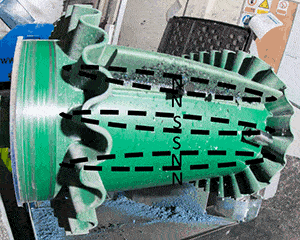Bunting explains the difference between axial, radial magnetic fields
Bunting explains the difference between axial, radial magnetic fields
<.gif)
An axial magnetic field is best for applications where the separation objective is to maximize the purity of the recovered ferrous metal, such as an auto recycling application where the purity of ferrous material recovered is essential in determining its resale value. However, recovery rates for ferrous metals may be slightly lower, according to the magnet manufacturer.
Bunting products that can feature axial magnetic fields include permanent drum magnets, electro drum magnets and pulley magnets.
In a radial magnetic field, poles are running in the same direction that the conveyor or drum is rotating. They follow the flow of the material, according to the manufacturer. Magnetically susceptible material will be attracted to the poles, which are the highest points of magnetic intensity, and held there until it is dragged out of the magnetic field.
A radial magnetic field is ideal when the goal is to maximize the amount of magnetic metal separated from other material, the company says. However, a radial magnetic field potentially can entrap nonmagnetic material, which then reduces the purity of the recovered metal that is separated.
Magnetic separators with radial magnetic field design are typically found in applications such as recovering magnetic minerals in mineral processing and also applications such as removing ferrous metals in certain recycling applications.
Bunting products featuring the radial magnetic field design include drum magnets, pulley magnets, rare earth roll separators and induced magnetic roll separators.
When deciding on the type of magnetic field to use in a specific application, a number of key factors should be considered:
- capacities that commonly determine burden depths;
- the separation objective;
- the purity target for the metal recovered;
- the separation target of the ferrous component; and
- the particle size of the metal.
For metal recycling operations, an axial magnetic field produces cleaner ferrous metal but results in a lower recovery rate because some ferrous can fall out with the nonferrous material, Bunting says. A radial magnetic field produces more ferrous metal that is less clean because some nonferrous material is removed along with the ferrous.
]]>
Source: Recycling Today
Bunting explains the difference between axial, radial magnetic fields
<
